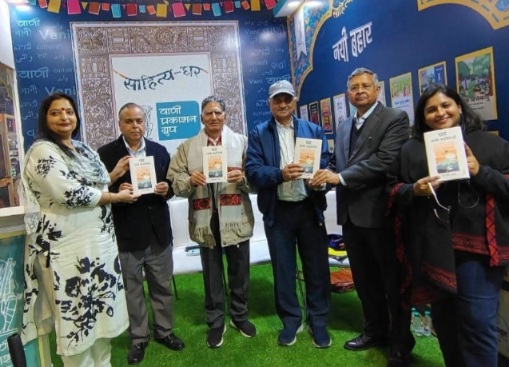New Delhi: The Delhi World Book Fair became the stage for a literary moment as two books by acclaimed writer S.R. Harnot were launched, sparking discussions on his distinctive storytelling—one that lays bare the paradoxes of Dalit existence within a society still shackled by its twice-born middle-class ideals.
The first book, S.R. Harnot Ki Chhah Kahaniyan (S.R. Harnot’s Six Stories), was launched at the Vani Prakashan stall by Arun Maheshwari, Director of Vani Prakashan, CEO Aditi Maheshwari Goyal, eminent critic Prof. Suraj Paliwal, senior novelist Hariyash Rai, and noted writer Vandana Yadav. Aditi Maheshwari Goyal remarked that this was the third book by Harnot published by Vani Prakashan, following the much-discussed Keelen (Nails) and the novel Nadi Rang Jaisi Ladki (A Girl Like River Colors), both of which received widespread reader appreciation and went into second editions in record time.
Goyal further noted that last year, at the London Book Fair, Harnot’s books were prominently displayed, underlining his growing global presence. "Harnot carries the Himalayas within him, and that is why his stories echo the voices of environmental concerns and cultural preservation," she said, adding that his narratives equally resonate with the struggles of the marginalized and women.
A Dalit Narrative in the Garb of the Universal
Prof. Paliwal, the keynote speaker, emphasized that he not only read Harnot deeply but also wrote extensively about his work. He described these six long stories as contemporary documents with a novelistic canvas, carrying strong socio-political themes. "Harnot’s storytelling is deceptively simple but layered with deep societal conflicts—his stories feel local but transcend into universal narratives," remarked novelist Hariyash Rai.
The six stories—Death Live, Mrityu Gandh, Ladki Gusse Mein Hai, Dev Khel, Ek Nadi Tadapti Hai, and a revised version of Fly Killer—have already been published in leading literary magazines, generating critical discourse.
Vandana Yadav, who moderated the session, highlighted that "simplicity in writing is the hardest thing to achieve, and that is the secret behind Harnot’s popularity."
The second book, Harnot Ki Pratinidhi Kahaniyan (Harnot’s Representative Stories), was published by Aadhar Prakashan and edited by renowned critic Dr. Vinod Shahi, who also contributed an extensive introduction. The book’s launch and discussion took place at Aadhar Prakashan’s stall.
Harnot’s Unfinished Social Liberation
Despite the praise, Harnot’s literary terrain remains an unsettling paradox—his characters remain caught between oppression and aspiration, between a past that refuses to fade and a present that struggles to evolve.
While his narratives reflect Dalit anxieties and Himalayan ecological concerns, they are yet to break free into a space where the twice-born middle-class society recognizes them as equals rather than subjects of literature.
His presence at the fair drew readers and research scholars alike. Additionally, he was a keynote speaker at a JNU event, and another discussion on his collection Keelen was organized by Delhi’s Mansi Foundation.
Yet, beyond the discussions and book launches, the question lingers: will the world of Harnot’s fiction find its long-awaited emancipation, or will it remain a literary paradox—read, debated, and displayed, but never truly liberated?





